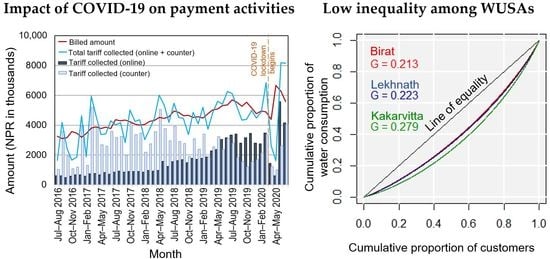Influence of Service Levels and COVID-19 on Water Supply Inequalities of Community-Managed Service Providers in Nepal
Abstract
:1. Introduction
2. Materials and Methods
2.1. Water Supply in Nepal
2.2. Performance Assessment of Water Service Providers
2.3. Selection of WUSAs
2.4. Data Collection
2.4.1. Water Pricing System
2.4.2. Bill Payment Data
2.4.3. Customers’ Water Consumption
2.4.4. Customer Interview
2.5. Data Analysis
3. Results
3.1. Performance Assessment of Service Providers
3.2. Data Profile of Five WUSAs
3.3. Water Tariff Payment
3.4. Block-Wise Distribution of Customers and Water Consumption
3.5. Consumption Variation within Customers
3.6. Multiple-Year Water Consumption Variation
3.7. Inequality of Water Consumption
3.7.1. Intermittency in Water Supply
3.7.2. Gini Coefficient of Water Consumption Volume
4. Discussion
4.1. Performance of Service Providers
4.2. Payment Activities
4.3. Block-Wise Water Consumption
4.4. Water Consumption Variation
4.5. Inequality Analysis
5. Conclusions
Author Contributions
Funding
Institutional Review Board Statement
Informed Consent Statement
Data Availability Statement
Acknowledgments
Conflicts of Interest
Appendix A
| Category | Birat | Lekhnath | Kakarvitta |
|---|---|---|---|
| All customers | All of the customers until FY 2019–2020 are included. | ||
| 4655 (residential = 4596, social = 22, academic = 15, business = 11, and office = 11) | 12,353 (residential = 12,144, social = 68, academic = 59, business = 53, office = 21, and health = 8) | 5796 (residential = 5658, social = 57, academic = 21, business = 17, office = 36, and health = 7) | |
| Continuing customers | New and terminated customers are excluded from all customers. | ||
| 3665 (residential = 3620, social = 12, academic = 15, business = 11, and office = 7) | 8003 (residential = 7881, social = 42, academic = 44, business = 25, and office = 11) | 4640 (residential = 4542, social = 35, academic = 20, business = 12, office = 26, and health = 5) | |
| Non-zero residential customers | Only residential customers consuming at least 1 m3/month are included in continuing customers. | ||
| 3010 | 5019 | 3319 | |
| Non-zero residential customers < = 50 m3/month | 2235 | 4057 | 2706 |
References
- World Bank Group. Reducing Inequalities in Water Supply, Sanitation, and Hygiene in the Era of the Sustainable Development Goals; World Bank: Washington, DC, USA, 2017. [Google Scholar]
- Ortigara, A.R.C.; Kay, M.; Uhlenbrook, S. A Review of the SDG 6 Synthesis Report 2018 from an Education, Training, and Research Perspective. Water 2018, 10, 1353. [Google Scholar] [CrossRef] [Green Version]
- United Nations Children’s Fund (UNICEF) and World Health Organization. Progress on Household Drinking Water, Sanitation and Hygiene 2000–2017. Special Focus on Inequalities; United Nations Children’s Fund (UNICEF) and World Health Organization: New York, NY, USA, 2019. [Google Scholar]
- Machado, A.V.M.; Santos, J.A.N.; Quindeler, N.S.; Alves, L.M.C. Critical Factors for the Success of Rural Water Supply Services in Brazil. Water 2019, 11, 2180. [Google Scholar] [CrossRef] [Green Version]
- Schweitzer, R.W.; Mihelcic, J.R. Assessing Sustainability of Community Management of Rural Water Systems in the Developing World. J. Water Sanit. Hyg. Dev. 2012, 2, 20–30. [Google Scholar] [CrossRef]
- Hutchings, P.; Chan, M.Y.; Cuadrado, L.; Ezbakhe, F.; Mesa, B.; Tamekawa, C.; Franceys, R. A Systematic Review of Success Factors in the Community Management of Rural Water Supplies over the Past 30 Years. Water Policy 2015, 17, 963–983. [Google Scholar] [CrossRef] [Green Version]
- Schouten, T.; Moriarty, P. Scaling up the Community Management of Rural Water Supply. Waterlines 2004, 23, 2–4. [Google Scholar] [CrossRef]
- Kanakoudis, V.; Tsitsifli, S. Doing the urban water supply job: From privatization to remunicipalisation and the third pillar of the Performance Based Service Contracts. Water Util. J. 2014, 8, 31–46. [Google Scholar]
- Donkor, E.A. Effect of customer satisfaction on water utility business performance. J. Awwa 2013, 105, E553–E560. [Google Scholar] [CrossRef] [Green Version]
- Ohwo, O.; Agusomu, T.D. Residential Customers Satisfaction with Public Water Provision in Ojota, Nigeria. Eur. Sci. J. 2018, 14. [Google Scholar] [CrossRef]
- Zeraebruk, K.; Mayabi, A.; Gathenya, J.; Tsige, Z. Assessment of Water Supply Services and Operational Performance of Asmara Water Supply Department (AWSD) for Development of Decision Support Tools. Environ. Nat. Resour. Res. 2014, 4, 208–222. [Google Scholar] [CrossRef] [Green Version]
- Nafi, A. Comprehensive Methodology for Overall Performance Assessment of Water Utilities. Water Resour. Manag. 2015, 29. [Google Scholar] [CrossRef]
- UN-Water. Sustainable Development Goal 6 Synthesis Report on Water and Sanitation 2018; United Nations: New York City, NY, USA, 2018. [Google Scholar]
- Government of Nepal. Water Resource Act, 2049 (1992); Ministry of Energy, Water Resources and Irrigation: Kathmandu, Nepal, 1992.
- Government of Nepal. Water Service Providers Data Book, 2069-2070 (2012–2013); Sector Efficiency Improvement Unit (SEIU), Ministry of Urban Development: Kathmandu, Nepal, 2014.
- Government of Nepal. Nepal Water Service Providers Data Book, 2070–2071 (2013–2014); Sector Efficiency Improvement Unit (SEIU), Ministry of Urban Development and Asian Development Bank, ADB Nepal Office: Kathmandu, Nepal, 2015.
- Government of Nepal. Water Service Providers Capacity Assessment and Benchmarking Data Year 2071-72 (2014–15) (NWSC, WSMB and KUKL); Sector Efficiency Improvement Unit (SEIU), Ministry of Water Supply and Sanitation: Kathmandu, Nepal, 2016.
- Balacco, G.; Totaro, V.; Iacobellis, V.; Manni, A.; Spagnoletta, M.; Piccinni, A.F. Influence of COVID-19 Spread on Water Drinking Demand: The Case of Puglia Region (Southern Italy). Sustainability 2020, 12, 5919. [Google Scholar] [CrossRef]
- Guragai, B.; Takizawa, S.; Hashimoto, T.; Oguma, K. Effects of Inequality of Supply Hours on Consumers’ Coping Strategies and Perceptions of Intermittent Water Supply in Kathmandu Valley, Nepal. Sci. Total Environ. 2017, 599–600, 431–441. [Google Scholar] [CrossRef] [PubMed]
- Keeley, B. Income Inequality: The Gap between Rich and Poor, OECD Insights; OECD Publishing: Paris, France, 2015. [Google Scholar] [CrossRef]
- Government of Nepal. Nepal—Annual Household Survey 2015–2016; Central Bureau of Statistics, National Planning Commission Secretariat: Kathmandu, Nepal, 2018.
- Murrar, A.; Awad, I.; Hasan, A.; Yaqob, E.; Barghothi, I.; Sadaqa, A.; Samhan, S.; Tamimi, A. The Impact of Water Price on the Financial Sustainability of the Palestinian Water Service Providers. J. Environ. Prot. 2017, 8, 1490–1508. [Google Scholar] [CrossRef] [Green Version]
- Kanakoudis, V.; Papadopoulou, A.; Tsitsifli, S. Domestic Water Pricing in Greece: Mean Net Consumption Cost versus Mean Payable Amount. Fresenius Environ. Bull. 2014, 23, 2742–2749. [Google Scholar]
- Kanakoudis, V.; Papadopoulou, A.; Tsitsifli, S. Domestic Water Pricing in Greece: A Spatial Differentiation. Desalination Water Treat. 2015, 54, 2204–2211. [Google Scholar] [CrossRef]
- Farley, M.; Wyeth, G.; Ghazali, Z.B.M.; Istandar, A.; Singh, S. The Manager’s Non-Revenue Water Handbook: A Guide to Understanding Water Losses; Dijk, N.V., Rakaskulthali, V., Kirkwood, E., Eds.; Ranhill Utilities Berhad and the United States Agency for International Development (USAID): Bangkok, Thailand, 2008. [Google Scholar]
- Tsavdaridou, A.; Kolokytha, E.; Mentes, A. Urban Water Consumption and New Metering Technologies: Application in the City of Thessaloniki. In Proceedings of the XI Protection and Restoration of the Enivironment (PRE) Conference 2012, Thessaloniki, Greece, 3–6 July 2012; pp. 203–212. [Google Scholar] [CrossRef]
- Khaing, K.S.; Kazama, S.; Takizawa, S. Assessment of Revenue Loss Due to Damaged Water Meters in Different Housing Types of Yangon City. Master’s Thesis, The University of Tokyo, Tokyo, Japan, 2020. [Google Scholar]
- Jang, D. A Parameter Classification System for Nonrevenue Water Management in Water Distribution Networks. Adv. Civ. Eng. 2018. [Google Scholar] [CrossRef]
- Hope, R.; Foster, T.; Krolikowski, A.; Cohen, I. Mobile Water Payment Innovations in Urban Africa; School of Geography and the Environment and Skoll Centre for Social Entrepreneurship at Said Business School, Oxford University: Oxford, UK, 2011. [Google Scholar]
- Amankwaa, G.; Asaaga, F.A.; Fischer, C.; Awotwe, P. Diffusion of Electronic Water Payment Innovations in Urban Ghana. Evidence from Tema Metropolis. Water 2020, 12, 1011. [Google Scholar] [CrossRef] [Green Version]
- Ezemenari, K.M.; Joshi, N.K.; Blum, F.M.; Varela, G.J.; Ganz Carulla, F. Nepal Development Update: Harnessing Export Potential for a Green, Inclusive, and Resilient Recovery; World Bank Group: Washington, DC, USA, 2021. [Google Scholar]
- Ibrahim A, S.; Memon, F.A.; Butler, D. Seasonal Variation of Rainy and Dry Season Per Capita Water Consumption in Freetown City Sierra Leone. Water 2021, 13, 499. [Google Scholar] [CrossRef]
- Nemati, M. COVID-19 and Urban Water Consumption. University of California, Giannini Foundation of Agricultural Economics, 2020. Are Update 2020, 24, 9–11. [Google Scholar]
- Abu-Bakar, H.; Williams, L.; Hallett, S.H. Quantifying the Impact of the COVID-19 Lockdown on Household Water Consumption Patterns in England. NPJ Clean Water 2021, 4, 1–9. [Google Scholar] [CrossRef]
- Kalbusch, A.; Henning, E.; Brikalski, M.P.; Luca, F.V.D.; Konrath, A.C. Impact of Coronavirus (COVID-19) Spread-Prevention Actions on Urban Water Consumption. Resour. Conserv. Recycl. 2020, 163, 105098. [Google Scholar] [CrossRef] [PubMed]
- Andey, S.P.; Kelkar, P.S. Influence of Intermittent and Continuous Modes of Water Supply on Domestic Water Consumption. Water Resour. Manag. 2009, 23, 2555–2566. [Google Scholar] [CrossRef]
- Bradley, R.M.; Weeraratne, S.; Mediwake, T.M.M. Water use projections in Developing Countries. J. AWWA 2002, 94, 52–63. [Google Scholar] [CrossRef]

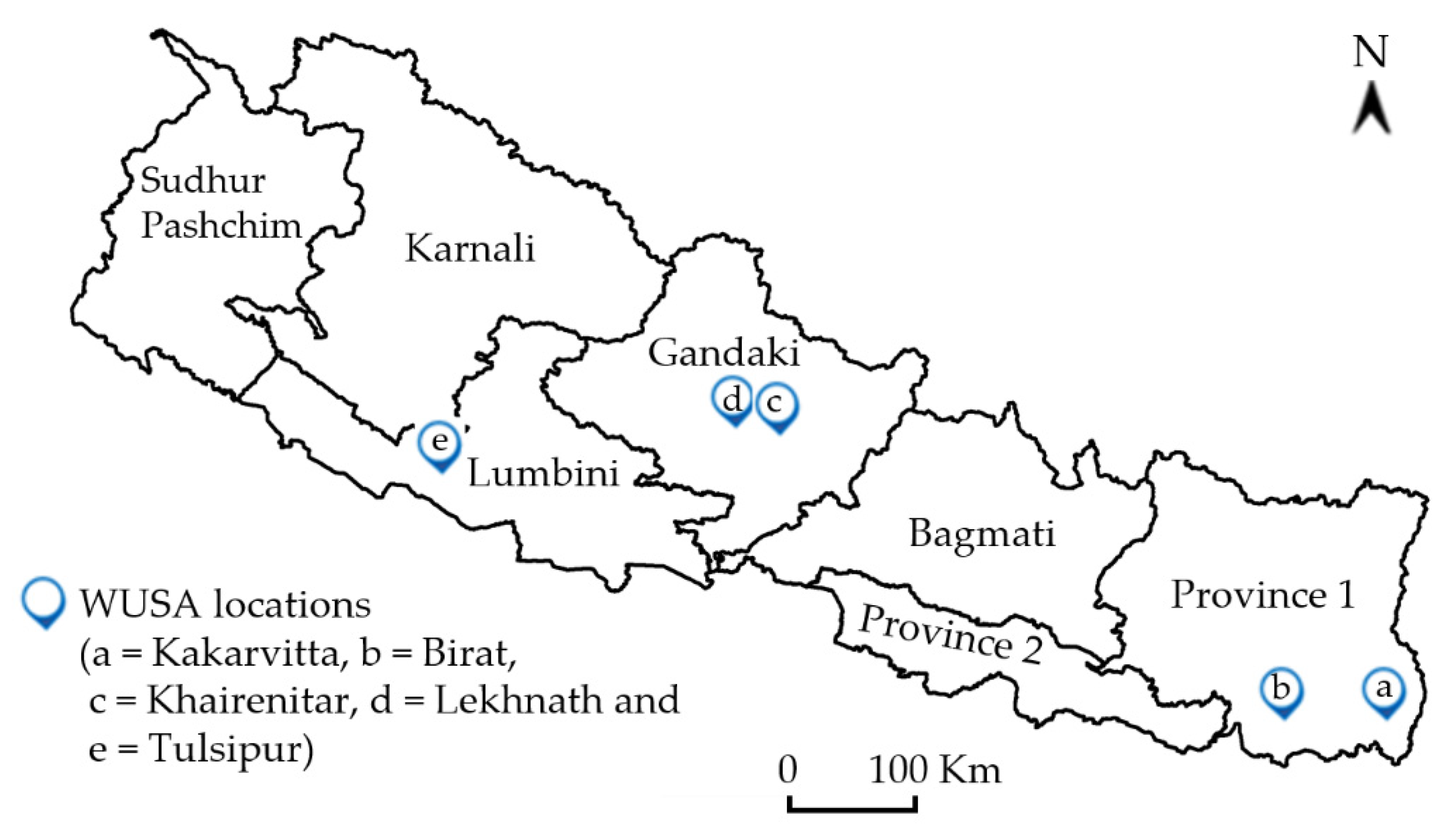
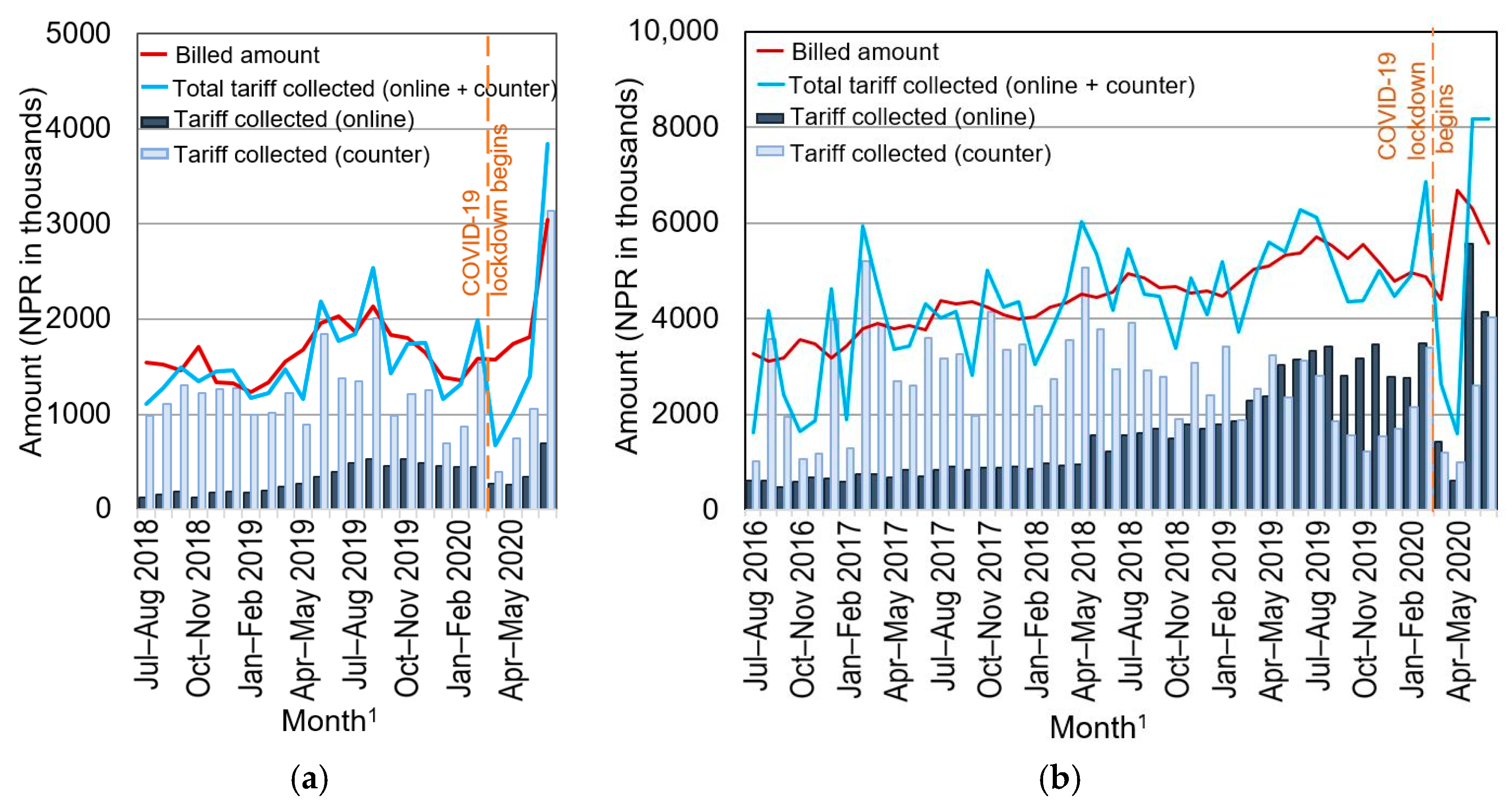

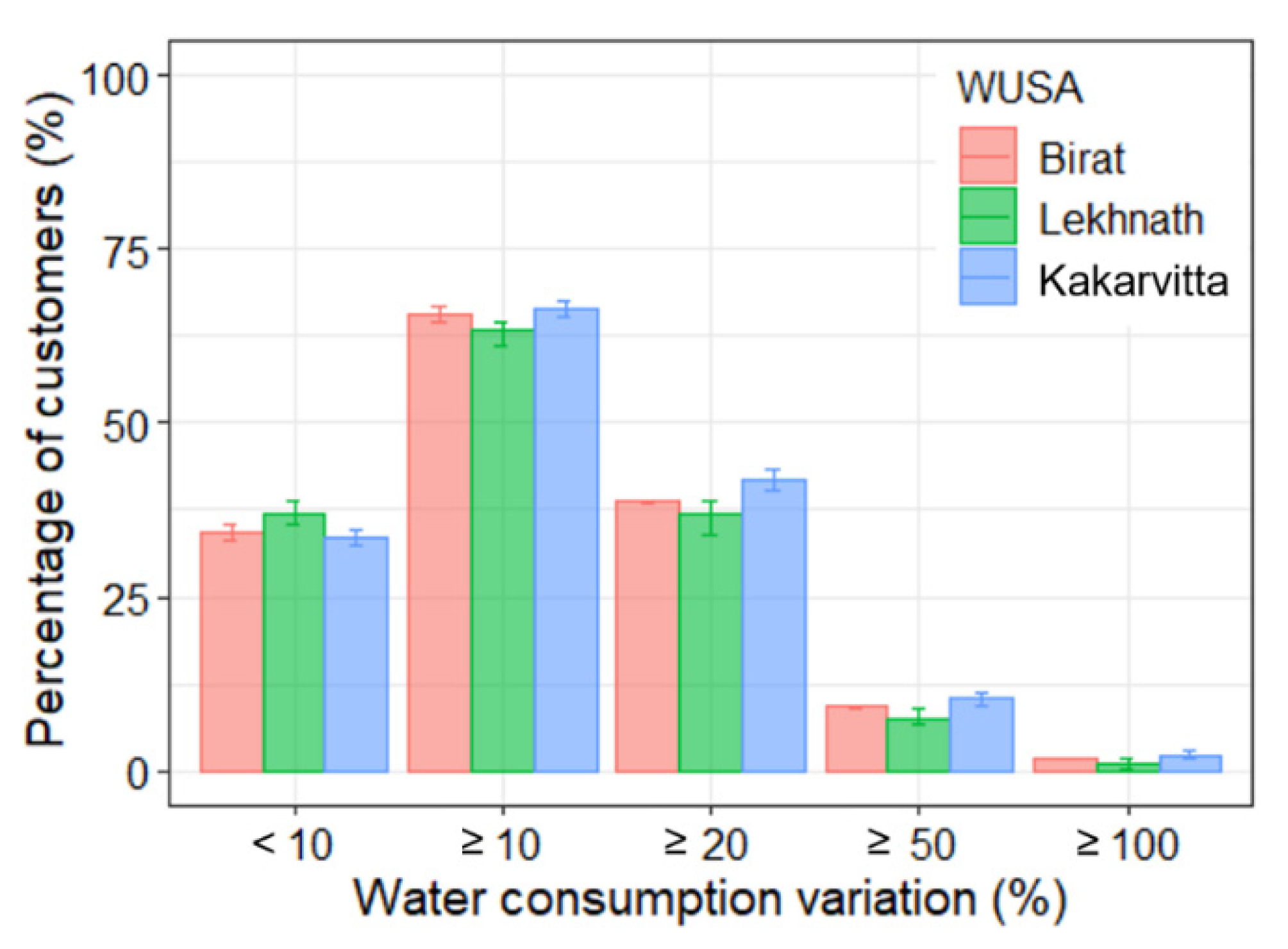
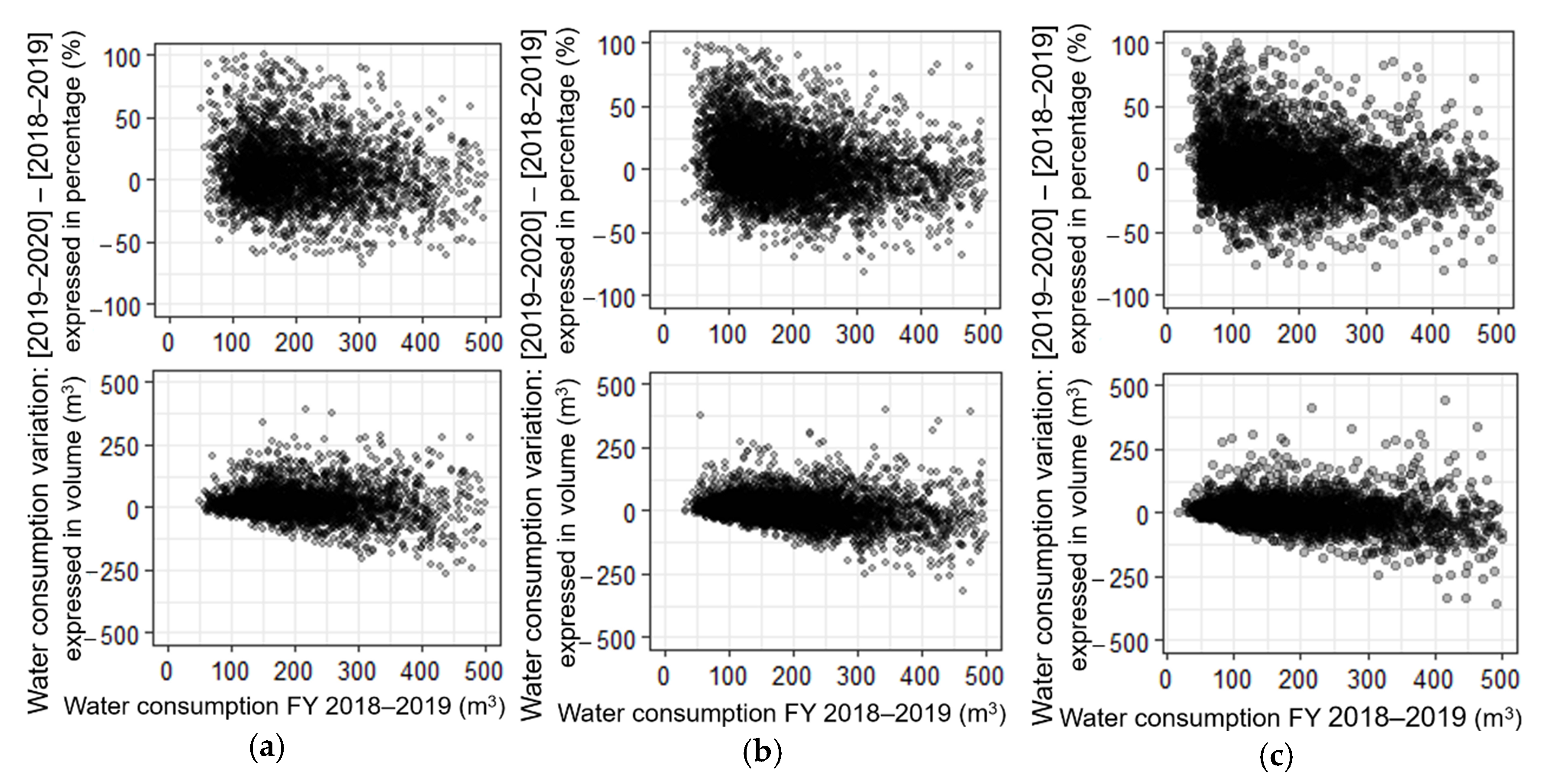
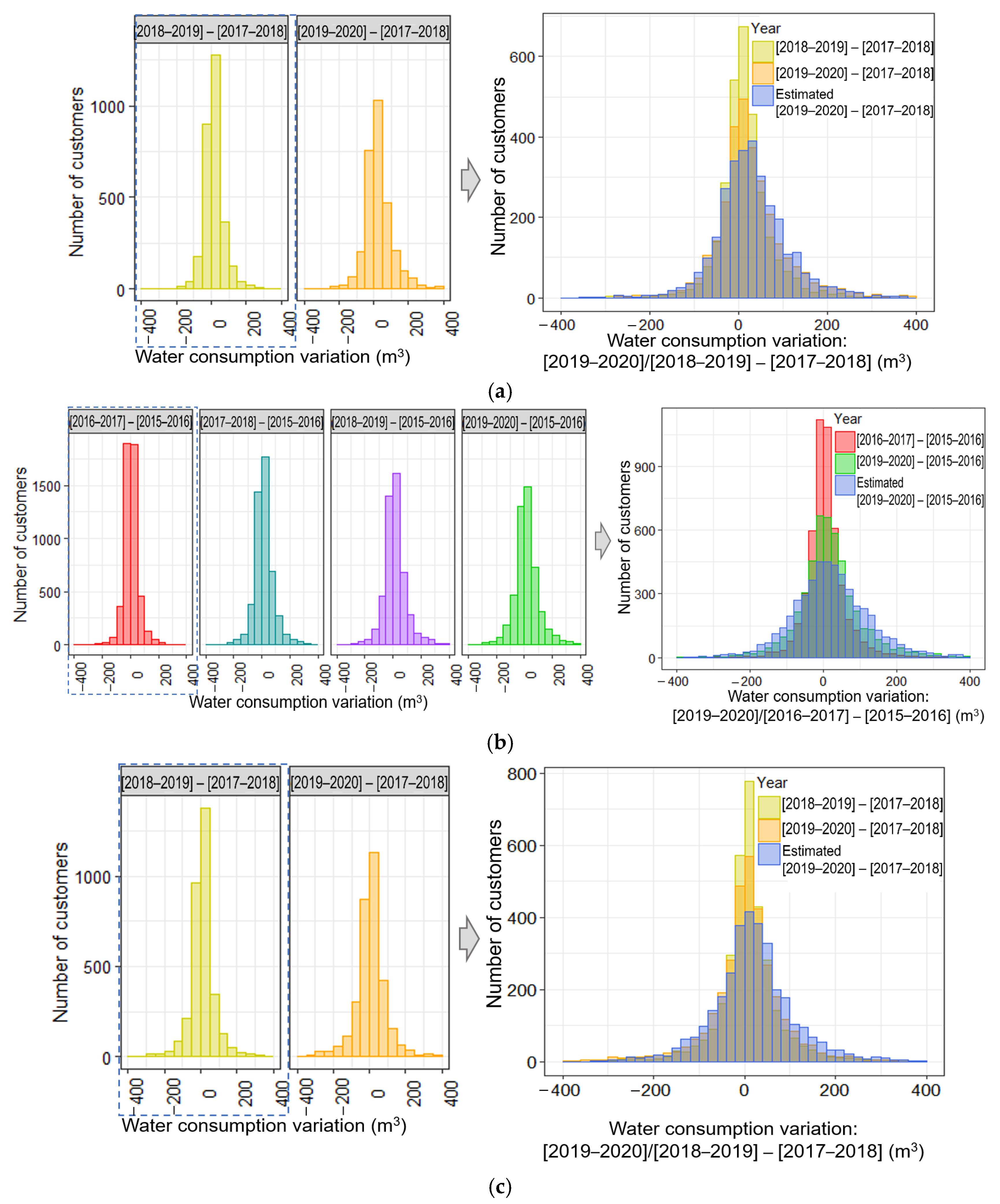
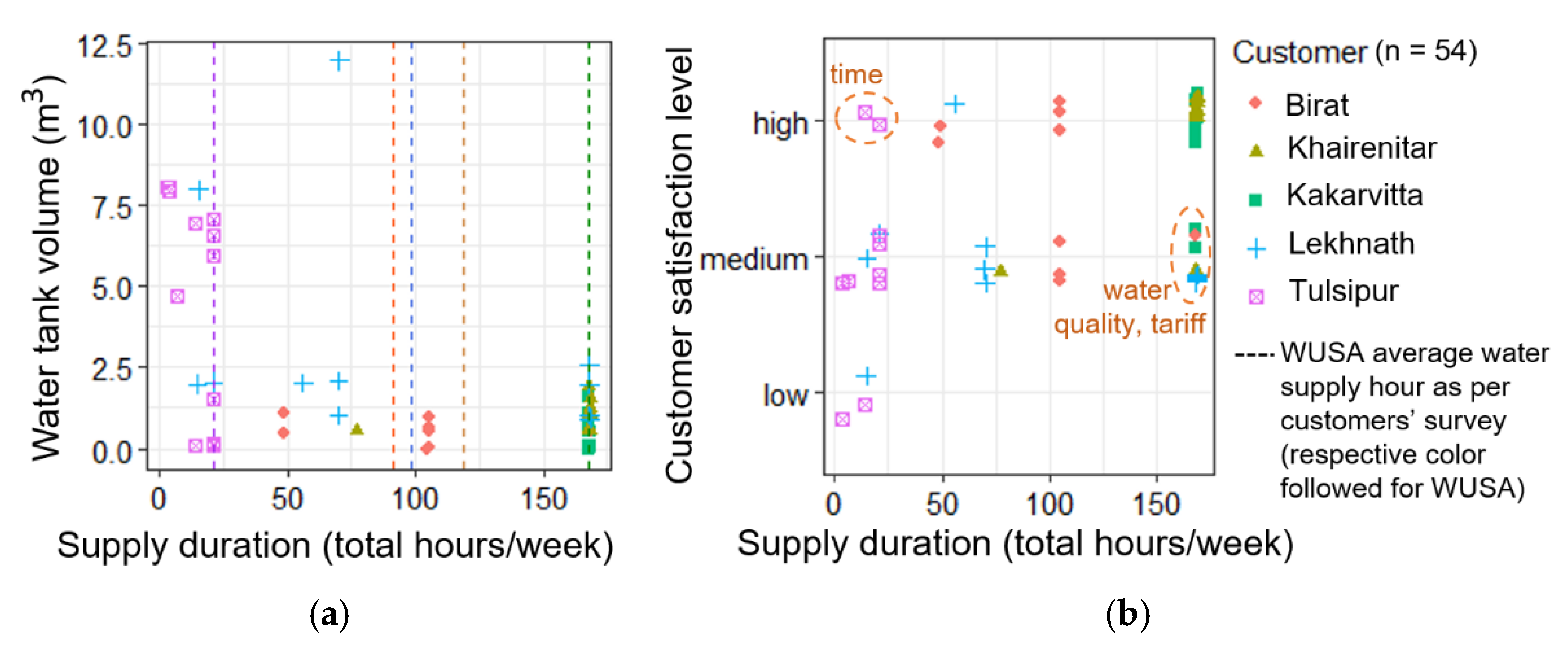
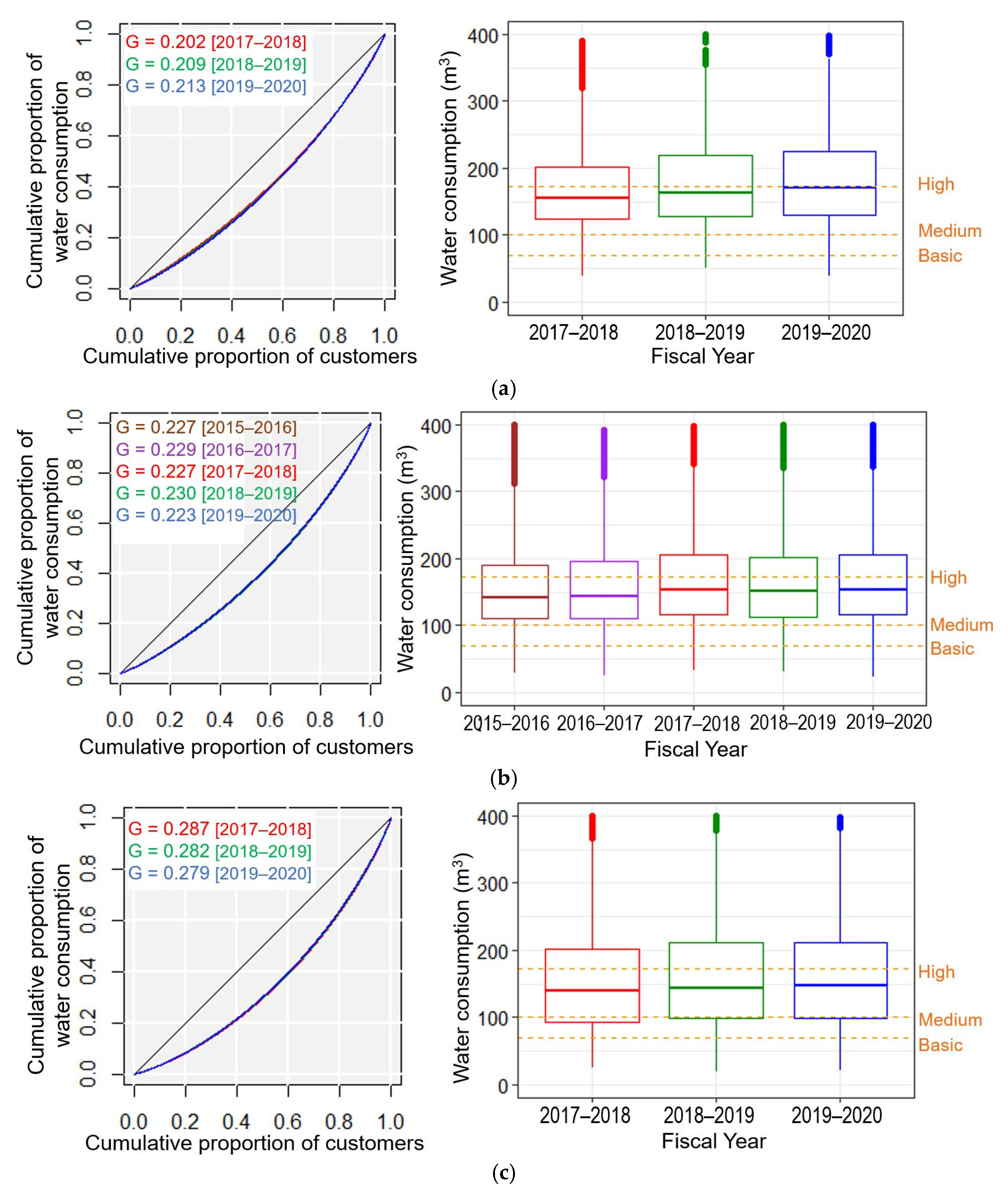
| Water Service Provider | Governing Act | Service Area | Remarks |
|---|---|---|---|
| Nepal Water Supply Corporation (NWSC) | Nepal Water Supply Corporation Act 1989 |
|
|
| Water Supply Management Board (WSMB) | Water Supply Management Board Act 2006 |
|
|
| Water Users and Sanitation Association (WUSA) | Water Resource Act 1992 |
|
|
| Service Indicators | Service Levels | ||
|---|---|---|---|
| Basic | Medium | High | |
| Quantity (LPCD 2) | ≥45 | ≥65 | ≥112 |
| Quality | Potable | NDWQS, 2005 3 | NDWQS, 2005 3 |
| Accessibility | ≥75% customers (public tap) | ≥50% customers (private tap) | ≥75% customers (private tap) |
| Supply duration (hours/day) 4 | 6–12 | 12–18 | 18–24 |
| Continuity | Year-round (7–14 days interruption acceptable/year) | Year-round (7 days interruption acceptable/year) | Year-round |
| Performance Indicators | WUSA | NWSC | WSMB | Total |
|---|---|---|---|---|
| (n = 52) | (n = 22) | (n = 3) | (n = 77) | |
| 1. Water supply coverage (%) | 65 (20–97) | 42 (14–98) | 72 (40–96) | 59 (14–98) |
| 2. Production/capita (LPCD) | 89 (35–208) | 140 (74–255) | 112 (56–161) | 104 (35–255) |
| 3. Consumption/capita (LPCD) | 70 (27–181) | 81 (54–109) | 79 (43–108) | 73 (27–181) |
| 4. Connections metered (%) | 94 (0–100) | 96 (84–100) | 97 (93–100) | 95 (0–100) |
| 5. NRW rate (%) | 22 (4–51) | 39 (12–65) | 29 (25–33) | 27 (4–65) |
| 6. Unit production cost (NPR/m3) 2 | 10 (3–35) | 13 (2–24) | 11 (7–18) | 11 (2–35) |
| 7. Average tariff (NPR/m3) 2 | 17 (4–47) | 14 (7–23) | 14 (11–17) | 16 (4–47) |
| 8. Operating ratio (%) | 86 (44–167) | 139 3 (20–280) | 87 (70–100) | 101 (20–280) |
| 9. Bill collection rate (%) | 99 (75–130) | 87 (70–100) | 87 (70–100) | 95 (70–130) |
| 10. Water supply (hours/day) | 12 (1–24) | 6 (2–12) | 7 (2–12) | 10 (1–24) |
| Description | Kakarvitta | Birat | Khairenitar | Lekhnath | Tulsipur |
|---|---|---|---|---|---|
| Water production (m3/day) 1 | 7970 | 5400 | 1555 | 10,716 | 7085 |
| Water consumption (m3/day) | 3476 | 2672 | NA | 6335 | 3662 |
| NRW rate (%) 2 | 56 | 50 | NA | 41 | 52 |
| Water supply (hours/day) | 24 | 14 | 10–24 | 14 | 3 |
| Staffs | 20 | 18 | 14 | 34 | 27 |
| Number of connections | 5894 | 4651 | 1603 | 12,110 | 5959 |
| Clear water tank (m3) | 1325 | 1025 | 710 | 2100 | 2301 |
| Water source 3 | GW | GW | GW, SW | GW, SW | GW, SW |
| Province | Province 1 | Province 1 | Gandaki | Gandaki | Lumbini |
| WUSA. | Fiscal Year (FY) | Mean (m3) | Median (m3) | SD |
|---|---|---|---|---|
| Birat | (2018–2019)–(2017–2018) | 15.21 | 10.50 | 57.53 |
| (2019–2020)–(2017–2018) | 27.47 | 17.50 | 79.16 | |
| Estimated (2019–2020)–(2017–2018) | 31.58 | 25.00 | 82.00 | |
| Lekhnath | (2016–2017)–(2015–2016) | 5.18 | 2.00 | 54.02 |
| (2017–2018)–(2015–2016) | 16.85 | 11.00 | 69.96 | |
| (2018–2019)–(2015–2016) | 14.76 | 9.00 | 79.02 | |
| (2019–2020)–(2015–2016) | 17.18 | 11.00 | 86.20 | |
| Estimated (2019–2020)–(2015–2016) | 21.46 | 17.00 | 106.94 | |
| Kakarvitta | (2018–2019)–(2017–2018) | 10.14 | 8.00 | 67.24 |
| (2019–2020)–(2017–2018) | 6.58 | 8.00 | 83.32 | |
| Estimated (2019–2020)–(2017–2018) | 20.18 | 17.00 | 90.93 |
Publisher’s Note: MDPI stays neutral with regard to jurisdictional claims in published maps and institutional affiliations. |
© 2021 by the authors. Licensee MDPI, Basel, Switzerland. This article is an open access article distributed under the terms and conditions of the Creative Commons Attribution (CC BY) license (https://creativecommons.org/licenses/by/4.0/).
Share and Cite
Shrestha, A.; Kazama, S.; Takizawa, S. Influence of Service Levels and COVID-19 on Water Supply Inequalities of Community-Managed Service Providers in Nepal. Water 2021, 13, 1349. https://doi.org/10.3390/w13101349
Shrestha A, Kazama S, Takizawa S. Influence of Service Levels and COVID-19 on Water Supply Inequalities of Community-Managed Service Providers in Nepal. Water. 2021; 13(10):1349. https://doi.org/10.3390/w13101349
Chicago/Turabian StyleShrestha, Arati, Shinobu Kazama, and Satoshi Takizawa. 2021. "Influence of Service Levels and COVID-19 on Water Supply Inequalities of Community-Managed Service Providers in Nepal" Water 13, no. 10: 1349. https://doi.org/10.3390/w13101349
APA StyleShrestha, A., Kazama, S., & Takizawa, S. (2021). Influence of Service Levels and COVID-19 on Water Supply Inequalities of Community-Managed Service Providers in Nepal. Water, 13(10), 1349. https://doi.org/10.3390/w13101349







